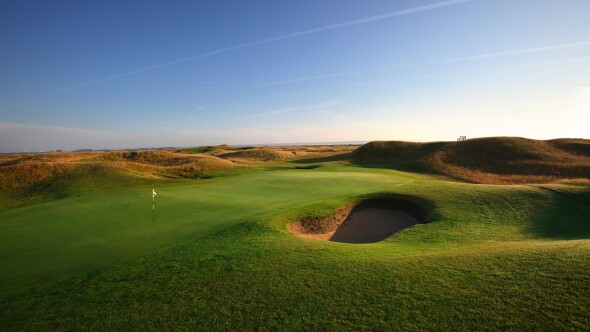Royal Cinque Ports Golf Club

About
| Tee | Par | Length | Rating | Slope |
|---|---|---|---|---|
| Black | 72 | 7381 yards | 76.9 | 148 |
| White | 72 | 6872 yards | 74.3 | 142 |
| Club | 72 | 6411 yards | 72.2 | 136 |
| Club (W) | 72 | 6411 yards | 78.6 | 150 |
| Purple | 72 | 5634 yards | 68.4 | 127 |
| Purple (W) | 72 | 5634 yards | 74.1 | 135 |
| Gold | 63 | 4332 yards | 62.5 | 103 |
| Gold (W) | 69 | 4332 yards | 66.1 | 117 |
| Hole | 1 | 2 | 3 | 4 | 5 | 6 | 7 | 8 | 9 | Out | 10 | 11 | 12 | 13 | 14 | 15 | 16 | 17 | 18 | In | Total |
|---|---|---|---|---|---|---|---|---|---|---|---|---|---|---|---|---|---|---|---|---|---|
| Black M: 76.9/148 | 420 | 434 | 566 | 151 | 600 | 356 | 413 | 169 | 458 | 3567 | 361 | 402 | 460 | 485 | 219 | 476 | 549 | 394 | 454 | 3800 | 7367 |
| White M: 74.3/142 | 359 | 395 | 566 | 151 | 545 | 323 | 413 | 169 | 406 | 3327 | 361 | 402 | 433 | 420 | 219 | 417 | 519 | 361 | 408 | 3540 | 6867 |
| Club M: 72.2/136 W: 78.6/150 | 346 | 359 | 510 | 139 | 498 | 291 | 368 | 160 | 386 | 3057 | 361 | 379 | 413 | 394 | 195 | 409 | 480 | 333 | 390 | 3354 | 6411 |
| Purple M: 68.4/127 W: 74.1/135 | 308 | 333 | 423 | 111 | 414 | 249 | 312 | 132 | 352 | 2634 | 326 | 362 | 391 | 340 | 153 | 373 | 416 | 303 | 337 | 3001 | 5635 |
| Handicap | 14 | 10 | 6 | 18 | 2 | 12 | 8 | 16 | 4 | 15 | 7 | 3 | 11 | 13 | 1 | 9 | 17 | 5 | |||
| Par | 4 | 4 | 5 | 3 | 5 | 4 | 4 | 3 | 4 | 36 | 4 | 4 | 4 | 4 | 3 | 4 | 5 | 4 | 4 | 36 | 72 |
| Handicap (W) | 12 | 8 | 4 | 18 | 2 | 14 | 6 | 16 | 10 | 11 | 3 | 13 | 5 | 15 | 1 | 7 | 17 | 9 |
Course Details
Rentals/Services
Practice/Instruction
Policies
Reviews
Reviewer Photos
A fun, fantastic links
This review is my recollection from a 2014 visit to Kent when I played Royal St. George's in the morning and the links locals call "Deal" in the afternoon.
RSG felt like the supermodel that I had no chance with. It was out of my league, so to speak, golf wise. By contrast, Deal felt like the cute, charming, approachable girl next door. It had such a welcoming vibe, both off the course and on. On the course, Deal was much more playable, quirky and interesting than RSG. There were more memorable blind shots and unique holes. Off the course, the clubhouse patio overlooking the bay felt like a great place for a pint while settling up a bet. I didn't have to don a jacket and tie to enjoy the facilities. Deal might be out of the modern Open rota, but it would be clearly on my playing rotation if I lived closer.
Great links course for a day trip from London
I was on a business trip to London and wanted to play some qualify links golf after a busy week. It's 1.5h from London St Pancras so it works out.
With wide fairway, short rough and perfect calm weather, this course is fun & easy. Some challenging blind tee shots and deep bunkers. But if you where to aim and avoid the pod bunkers, then the rest is enjoyable. Every hole is different. I do think hole 1 and hole 18 are a bit plain.
I also played a nearby much more famous Royal St George. I enjoy RCP more b/c RSG is more difficult (more bunkers and dome-shape greens). RCP has the right mix of difficult and fun holes for me.




























